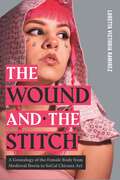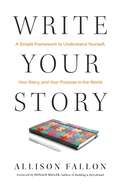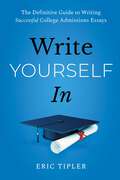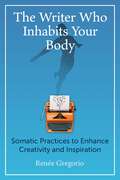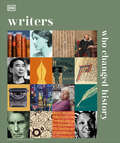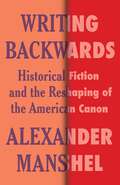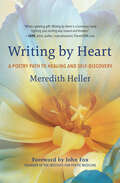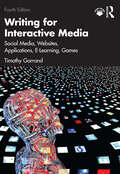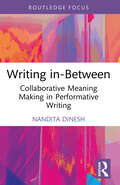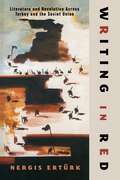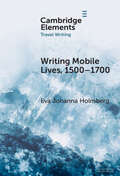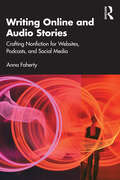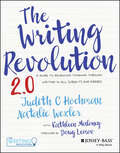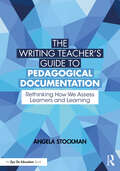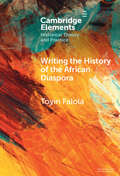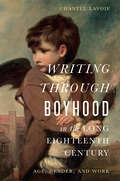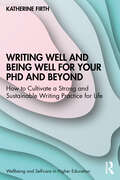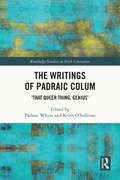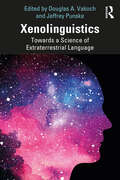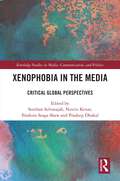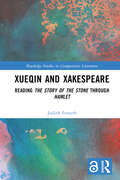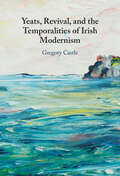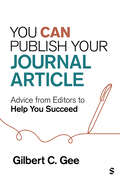- Table View
- List View
The Wound and the Stitch: A Genealogy of the Female Body from Medieval Iberia to SoCal Chicanx Art (RSA Series in Transdisciplinary Rhetoric)
by Loretta Victoria RamirezThe Wound and the Stitch traces a history of imagery and language centered on the concept of woundedness and the stitching together of fragmented selves. Focusing particularly on California and its historical violences against Chicanx bodies, Loretta Victoria Ramirez argues that woundedness has become a ubiquitous and significant form of Chicanx self-representation, especially in late twentieth-century print media and art.Ramirez maps a genealogy of the female body from late medieval Iberian devotional sculptures to contemporary strategies of self-representation. By doing so, she shows how wounds—metaphorical, physical, historical, and linguistic—are inherited and manifested as ongoing violations of the body and othered forms of identity. Beyond simply exposing these wounds, however, Ramirez also shows us how they can be healed—or rather stitched. Drawing on Mesoamerican concepts of securing stability during lived turmoil, or nepantla, Ramirez investigates how creators such as Cherríe Moraga, Renee Tajima-Peña, Guillermo Gómez-Peña, and Amalia Mesa-Bains repurpose the concept of woundedness to advocate for redress and offer delicate, ephemeral moments of healing.Positioning woundedness as a potent method to express Chicanx realities and transform the self from one that is wounded to one that is stitched, this book emphasizes the necessity of acknowledgment and ethical restitution for colonial legacies. It will be valued by scholars and students interested in the history of rhetorics, twentieth-century Chicanx art, and Latinx studies.
Write Your Story: A Simple Framework to Understand Yourself, Your Story, and Your Purpose in the World
by Allison FallonAllison Fallon&’s Write Your Story provides a simple framework that will help readers capture, in writing, the depth of life events and, in turn, to make sense of their lives.Once you understand yourself and your life, you will live with more purpose and confidence. We&’ve all spent seasons reacting to the world around us, as though the world were telling a story and we were simply the audience, bystanders watching it all happen. The result: a life of regret and a feeling that we missed our purpose. Author Allison Fallon has led thousands of people just like you to find greater meaning by helping them write their story. She&’s witnessed the phenomenon of a person stepping back, analyzing their life, and realizing what they&’re good at and what they are not, the types of people who hurt them and those who help, and the things that provide satisfaction and what leaves them empty. And in all this, they find their purpose. They find their story. When you know your story, you know who you are and why you matter. You understand the many ways you can help others, and you develop a resilience over pain that can make you unstoppable. Allison&’s simple formula will help you process your life and get your whole story down—in only five pages! This isn&’t a formula to teach you to write a book (although the exercises may lead to that), but it will help you understand yourself, your story, and your purpose. We will never know who we are until we know our story. And we will never know our story until we take time to write it down. So let&’s begin.
Write Yourself In: The Definitive Guide to Writing Successful College Admissions Essays
by Eric TiplerWrite authentic, memorable college essays that will help you get into the right school for you with this guidebook from a veteran college admissions expert.Every spring, over one million high school juniors embark on an annual rite of passage: applying to college. And with college admission rates at an all-time low, getting into a competitive school is now tougher than ever. At the top schools, a strong transcript and great test scores will get your application noticed, but it&’s your essays, and the personal story that they highlight, that will get you admitted. But often, students don&’t know where to start. Teens fret over topics because they don&’t know what college admissions officers are looking for. They bend over backwards to write what they think colleges want to read, instead of telling their authentic story—which is what admissions officers actually want—in a way that will resonate with their readers. They also struggle because college essays, which are narrative, first-person, and introspective require a different set of skills from academic, expository writing they&’ve been learning for years in the classroom. Seasoned college admissions expert and educator Eric Tipler has seen this firsthand. Teens and their parents spend countless, anxiety-filled hours crafting and refining essays that are often lackluster. In Write Yourself In, Tipler meets students where they are, and provides comprehensive actionable advice in a warm and conversational tone. He demonstrates how to craft a winning essay, one that is authentic, vulnerable, and demonstrative of qualities like personal growth and emotional maturity. Instead of formulas, Write Yourself In gives students step-by-step processes for brainstorming, outlining, writing, and revising essays. It encourages them to seek out feedback at key points in the process, something Tipler has found to be vital to helping students produce their best writing. Further, the book includes sidebars that teach essential components of good storytelling, a &“secret weapon&” in the admissions process. In addition to the admissions essay, Write Yourself In also covers the most common supplemental essays on topics like community, diversity, openness to others&’ viewpoints, and why their school is a good fit for the student scholarship essays, as well as scholarship essays. Tipler includes sections that address current topics like the widespread use of ChatGPT and the discussion of race in the admissions essay, a facet of the student&’s application that will have newfound importance given the Supreme Court decision on affirmative action. Written with both the parent and teen in mind, Write Yourself In is the go-to handbook for writing a great college essay.
The Writer Who Inhabits Your Body: Somatic Practices to Enhance Creativity and Inspiration
by Renée Gregorio• Provides a comprehensive, step-by-step program for writers to use their bodies to expand their creative capacity on the page and in their lives • Offers hands-on exercises, rooted in the disciplines of Aikido and somatics, to help writers center themselves and better access their authentic inner voice • Helps writers confront obstacles like fear, doubt, and difficult emotions, transforming such subject matter into opportunities for creative exploration Writing is one of our most fundamental means of spiritual expression, a powerful capacity that enables us to shape and share our deepest thoughts, feelings, and experiences. Yet the writing process can be challenging and imprecise, and both novice and experienced writers may struggle with accessing their innermost creative selves. Taking an embodied approach to writing, poet and Aikido practitioner Renée Gregorio offers a step-by-step experiential program to help you to center yourself in your body and, in so doing, expand your creative capacity on the page and in your life. Rather than provide a guide to writing, she helps you identify and give voice to the writer within. She shares hands-on exercises rooted in the martial art of Aikido and the practice of somatics—or body-centered learning—to provide direct and detailed ways to help facilitate personal growth and tap in to innate creative capacities, enabling you to fully immerse yourself in the creative process and discover immediate benefits. Drawing on her extensive martial arts training, the author emphasizes creating your own internal writing &“dojo&” to clear the mind and enable you to access the deeper currents of language. Exploring discomfort as a doorway to deeper experience and new writing territory, she reveals how to examine difficult topics, express the full range of emotions, and turn self-doubt, fear, and painful experience into courage. She also explores how to unearth the power and physicality in your own voice, using techniques like &“re-visioning&” to effectively edit your work, ultimately embodying your writing with complexity and fullness. Through immersive and physically focused experience, this book will help seasoned and aspiring writers alike work with the body as a wise teacher to better access, hone, and express their authentic inner voice.
Writers Who Changed History (DK History Changers)
by DKExplore the fascinating lives and loves of the greatest novelists, poets, and playwrights.Lavishly illustrated with photographs and paintings of writers’ homes, studies, and personal artifacts—along with pages from original manuscripts, first editions, and their correspondence—Writers Who Changed History introduces the key ideas, themes, and literary techniques of each writer, revealing the imaginations and personalities behind some of the world’s greatest novels, short stories, poems, and plays.Introduced with a stunning portrait of each featured novelist, playwright, or poet, biographical entries trace the friendships, loves, and rivalries that inspired each individual and influenced their work, revealing insights into the larger-than-life characters, plots, and evocative settings that they created. Each entry explains how the person’s writing developed during their lifetime and sets it in context, conveying a powerful sense of the place and the period of history in which they lived.Covering an eclectic range of authors from the Middle Ages to the present day, Writers Who Changed History provides a compelling glimpse of the lives and loves of each great writer.
Writing Backwards: Historical Fiction and the Reshaping of the American Canon (Literature Now)
by Alexander ManshelContemporary fiction has never been less contemporary. Midcentury writers tended to set their works in their own moment, but for the last several decades critical acclaim and attention have fixated on historical fiction. This shift is particularly dramatic for writers of color. Even as the literary canon has become more diverse, cultural institutions have celebrated Black, Asian American, Latinx, and Indigenous novelists almost exclusively for their historical fiction.Writing Backwards explores what the dominance of historical fiction in the contemporary canon reveals about American literary culture. Alexander Manshel investigates the most celebrated historical genres—contemporary narratives of slavery, the World War II novel, the multigenerational family saga, immigrant fiction, and the novel of recent history—alongside the literary and academic institutions that have elevated them. He examines novels by writers including Toni Morrison, Viet Thanh Nguyen, Colson Whitehead, Julia Alvarez, Leslie Marmon Silko, Michael Chabon, Julie Otsuka, Yaa Gyasi, Ben Lerner, and Tommy Orange in the context of MFA programs, literary prizes, university syllabi, book clubs, and the National Endowment for the Arts. Manshel studies how historical fiction has evolved over the last half century, documenting the formation of the newly inclusive literary canon as well as who and what it still excludes. Offering new insight into how institutions shape literature and the limits of historical memory, Writing Backwards also considers recent challenges to the historical turn in American fiction.
Writing by Heart: A Poetry Path to Healing and Self-Discovery
by Meredith HellerWrite to Explore and Express the Wild Beauty of Your Heart Meredith Heller invites you to write as a path toward self-understanding and as a lifelong refuge of steadfast friendship with yourself. She used the power of writing to heal and save her own life, and now she teaches others to do the same. In this book, Meredith shares the techniques she developed to help people from all walks of life explore their emotions, find their voice, and better navigate life’s challenges. Filled with potent exercises and inspiring poems from the author and her students, Writing by Heart is a must-read for anyone, from seasoned writer to novice, who wants to discover the transformative power of writing.
Writing for Interactive Media: Social Media, Websites, Applications, e-Learning, Games
by Timothy GarrandThis thoroughly revised fourth edition teaches students and professionals how to create interactive content for all types of new media and become successful writers or designers in a variety of fields. This comprehensive guide is grounded in the core principles and skills of interactive media writing, in which writers create text and structure content to guide users through interactive products such as websites or software. The book examines case studies on interactive formats including complex informational websites, computer games, e-learning courses, training programs, and immersive exhibits. These case studies assess real-world products and documentation used by professional writers such as scripts, outlines, screenshots, and flowcharts. The book also provides practical advice on how to use interactive media writing skills to advance careers in the social media, technical, instructional communication, and creative media fields. This edition includes new chapters on UX Writing and Content Design, Social Media Writing, and Writing for Mobile. Writing for Interactive Media prepares students for the writing challenges of today’s technology and media. It can be used as a core textbook for courses in UX Writing, Writing for Digital Media, and Technical and Professional Communication and is a valuable resource for writing professionals at all levels. Supplemental resources include a sample syllabus, class assignments, student exercises, scripts, outlines, flowcharts, and other interactive writing samples. They are available online at www.routledge.com/9781032554242
Writing in-Between: Collaborative Meaning Making in Performative Writing (Routledge Focus on Literature)
by Nandita DineshWriting in-Between lies at intersections: between theory and praxis; between fiction and non-fiction; between author and reader; between the personal and the political. Beginning with a conceptual glossary that prepares readers for their journey through the book, Dinesh offers two central texts to invite readers to become co-creators. The first, F for _____, is written as an “academic novella” and culminates with an interactive section that is composed of guided invitations for the reader/co-creator. The second text, Julys, takes the form of a “dramatic memoir” and intersperses invitations for readers/co-creators between each of its chapters. Dinesh brings these threads together in an entirely interactive concluding chapter, where her hopes for collaborative meaning making take centre stage. In all of its unique invitations to engage, Dinesh’s readers/co-creators can either choose to craft their creations in personal notebooks or blank spaces in this work’s physical copy, or to engage more publicly via virtual forums that can be accessed via QR codes and accompanying links that are scattered throughout the book. Guided by questions about writing can “do” — questions that have shaped Dinesh’s work as an artist, scholar, and educator for almost two decades — Writing in Between embodies one central tenet: that the significance of performative writing might be most powerfully experienced through a collaborative process of meaning making between a text’s author and its readers turned co-creators.
Writing in Red: Literature and Revolution Across Turkey and the Soviet Union (Modernist Latitudes)
by Nergis ErtürkThe republic of Turkey and the Soviet Union both emerged from the wreckage of empires surrounding World War I, and pathways of literary exchange soon opened between the two revolutionary states. Even as the Turkish government pursued a friendly relationship with the USSR, it began to persecute communist writers. Whether going through official channels or fleeing repression, many Turkish writers traveled to the Soviet Union during the 1920s and 1930s, publishing original work, editing prominent literary journals, and translating both Russian classics and Soviet literature into Turkish.Writing in Red traces the literary and exilic itineraries of Turkish communist and former communist writers, examining revolutionary aesthetics and politics across Turkey and the Soviet Union from the mid-1920s through the 1960s. Nergis Ertürk considers a wide range of texts—spanning genres such as erotic comedy, historical fiction and film, and socialist realist novels and theater—by writers including Nâzim Hikmet, Vâlâ Nureddin, Nizamettin Nazif, Suat Derviş, and Abidin Dino. She argues that these works belong simultaneously to modern Turkish literature, a transnational Soviet republic of letters, and the global literary archive of world revolution, alongside those of other writers who made the “magic pilgrimage” to Moscow. Exploring how Turkish communist writers on the run produced a remarkable transnational literature of dissent, Writing in Red offers a new account of global revolutionary literary culture.
Writing Mobile Lives, 1500–1700 (Elements in Travel Writing)
by null Eva Johanna HolmbergThis Element develops and showcases a new methodological framework in which to study the connections between early modern travel writing and life- and self-writing. Turning the scholarly focus in the study of travel writing from eye-witnessing and proto-ethnography of foreign lands to the 'fashioned' and portrayed selves and 'inner worlds' of travellers – personal memory, autobiographical practices, and lived yet often heavily mediated travel experiences – it opens up perspectives to travel writing in its many modes, that extend both before and after 'lived' travels into their many pre- and afterlives in textual form. This title is also available as Open Access on Cambridge Core.
Writing Online and Audio Stories: Crafting Nonfiction for Websites, Podcasts, and Social Media
by Anna FahertyGuiding readers through the unique challenges and choices presented by digital publication, this book provides a practical set of tools to help students, creatives, and content professionals craft emotionally engaging nonfiction stories for online readers and listeners. From considering what story to tell, to bringing narratives to life in practice, Anna Faherty explains what gives stories their unique power and demonstrates how to successfully combine techniques from short-stories and screenwriting with journalistic practices like fact checking and verification. Examples from corporate websites, personal blogs, podcasts, and social media set out how to attract and involve readers and listeners, and how to prompt them to take action. Readers will come away with a straightforward framework for planning and crafting storytelling projects and an understanding of text and script development, copyright, and editing. Each chapter includes summaries of key principles and practical writing tips, while case studies share insights from writers’ professional practices – including those who use storytelling to influence customers or advocate for change. Writing Online and Audio Stories is a valuable entry-point for creative writers, podcasters, and professionals in PR and marketing, as well as students undertaking courses such as Digital Writing, Creative Nonfiction and Multimedia Storytelling.
The Writing Revolution 2.0: A Guide to Advancing Thinking Through Writing in All Subjects and Grades
by Natalie Wexler Judith C. HochmanLead a writing revolution in your classroom with the proven Hochman Method Building on the success of the original best-seller, this new edition of The Writing Revolution adds valuable guidance for teachers seeking a way to bring their students' writing ability up to rigorous state standards. As thousands of educators have already discovered, The Writing Revolution provides the road map they need, clearly explaining how to incorporate the Hochman Method into their instruction, no matter what subject or grade they're teaching and regardless of the ability level of their students. The new edition provides a reorganized sequence of activities and even more student-facing examples, making it easier than ever to bring the method to your classroom. The Writing Revolution isn't a separate curriculum or program teachers need to juggle. Rather, it is a method providing strategies and activities that teachers can adapt to their preexisting curriculum and weave into their content instruction. By focusing on specific techniques that match their students' needs and providing them with targeted feedback, The Writing Revolution can turn weak writers into strong and confident communicators. In addition, the method can: Identify misconceptions and gaps in knowledge Boost reading comprehension and learning Improve organizational skills Enrich oral language Develop analytical abilities The Writing Revolution takes the mystery out of teaching students to write well.
The Writing Teacher’s Guide to Pedagogical Documentation: Rethinking How We Assess Learners and Learning
by Angela StockmanThis book is a call to action for English and English Language Arts teachers who understand that data are not numbers alone, learning is impossible to quantify, and students are our very best teachers. Writing teacher Angela Stockman shows us how pedagogical documentation—the practice of making learning visible, capturing what is seen and heard, and then interpreting those findings in the company of our students and our colleagues—is a humbling and humane practice that grounds what we think we’ve come to know in the lived experiences of those we intend to serve. In this rich resource, she offers: processes and protocols for documenting learning and analyzing data; resources and planning tools to help you design and execute your own projects; and a digital documentation notebook that you can download for guidance, inspiration, and examples. With the powerful tools in this book, you’ll be inspired to reach students whose needs have been ignored by big data and whose identities have been erased by oppressive forms of assessment and evaluation.
The Writing Teacher’s Guide to Pedagogical Documentation: Rethinking How We Assess Learners and Learning
by Angela StockmanThis book is a call to action for English and English Language Arts teachers who understand that data are not numbers alone, learning is impossible to quantify, and students are our very best teachers.Writing teacher Angela Stockman shows us how pedagogical documentation—the practice of making learning visible, capturing what is seen and heard, and then interpreting those findings in the company of our students and our colleagues—is a humbling and humane practice that grounds what we think we’ve come to know in the lived experiences of those we intend to serve. In this rich resource, she offers: processes and protocols for documenting learning and analyzing data; resources and planning tools to help you design and execute your own projects; and a digital documentation notebook that you can download for guidance, inspiration, and examples With the powerful tools in this book, you’ll be inspired to reach students whose needs have been ignored by big data and whose identities have been erased by oppressive forms of assessment and evaluation.
Writing the History of the African Diaspora (Elements in Historical Theory and Practice)
by null Toyin FalolaThis Element is an analysis of the African Diaspora. It will define the African Diaspora and how the concepts behind the term came to be socially and historically engineered. The African diaspora is then placed into a broader historical context where the diverse, global, and overlapping histories of Africa's ancient-ongoing diasporas will be explored. In particular, themes of injustice, agency, resistance, and diversity (regarding people, diasporas, and experiences) will feature heavily. Through this exploration, this Element will interrogate dominating narratives regarding African diaspora-related discourse, seeking to address prevailing ideas that inadequately capture the true complexity and nuance of the subject. It does so to construct a more comprehensive understanding of the subject matter while lining out a more holistic approach to thinking about the very nature of 'diaspora.' Finally, this Element will analyze the present circumstances of the African diaspora, bringing into conversation a progressively global and connected world.
Writing through Boyhood in the Long Eighteenth Century: Age, Gender, and Work
by Chantel LavoieWriting through Boyhood in the Long Eighteenth Century explores how boyhood was constructed in different creative spaces that reflected the lived experience of young boys through the long eighteenth century—not simply in children’s literature but in novels, poetry, medical advice, criminal broadsides, and automaton exhibitions. The chapters encompass such rituals as breeching, learning to read and write, and going to school. They also consider the lives of boys such as chimney sweeps and convicted criminals, whose bodily labor was considered their only value and who often did not live beyond boyhood. Defined by a variety of tasks, expectations, and objectifications, boys—real, imagined, and sometimes both—were subject to the control of their elders and were used as tools in the cause of civil society, commerce, and empire. This book argues that boys in the long eighteenth century constituted a particular kind of currency, both valuable and expendable—valuable because of gender, expendable because of youth.
Writing Well and Being Well for Your PhD and Beyond: How to Cultivate a Strong and Sustainable Writing Practice for Life (Wellbeing and Self-care in Higher Education)
by Katherine FirthPrioritizing wellbeing alongside academic development, this book provides practical advice to help students write well, and be well, during their PhD and throughout their career. In this unique book, Katherine Firth offers expert guidance on developing a writing practice and avoiding burnout, providing strategies and insights for developing a sustainable writing career beyond the PhD thesis. The book covers every stage of the academic writing process, from planning and researching, through getting words on the page, to the often unexpectedly time-consuming editing and polishing. Readers are reminded that writing a thesis is hard work, but it needn’t be damaging work. Each chapter includes a toolbox of strategies and techniques, such as meditations, writing exercises and tips to maintain physical wellbeing, that will help doctoral candidates start writing and keep writing, without sacrificing their health, wellbeing or relationships. Relevant at any stage of the writing process, this book will help doctoral students and early career researchers to produce great words that people want to read, examiners want to pass and editors want to publish.
The Writings of Padraic Colum: ‘That Queer Thing, Genius’ (Routledge Studies in Irish Literature)
by Pádraic Whyte Keith O’SullivanThis co-edited collection breaks new ground by bringing together several leading scholars to explore the substantial body of work produced by Padraic Colum (1881–1972) who was a poet, a novelist, a dramatist, a biographer, a writer of fiction for adults and children, and a collector of folklore. The awards, honours, and distinction conferred upon him and his work throughout his life and career, as well as retrospectively, give an indication of the significant and wide-ranging appeal and influence of Colum not only as an Irish writer and storyteller but also as a literary figure entrusted with the myths and legends of other cultures and nations. Despite such achievements, he has received comparatively little critical or scholarly attention to date. This volume showcases the richness of Colum’s work by subjecting it to a rigorous literary and theoretical examination and is the first combined and detailed analysis of both his children’s and adult texts.
Xenolinguistics: Towards a Science of Extraterrestrial Language
by Douglas A. Vakoch Jeffrey PunskeXenolinguistics brings together biologists, anthropologists, linguists, and other experts specializing in language and communication to explore what non-human, non-Earthbound language might look like. The 18 chapters examine what is known about human language and animal communication systems to provide reasonable hypotheses about what we may find if we encounter non-Earth intelligence. Showcasing an interdisciplinary dialogue between a set of highly established scholars, this volume: Clarifies what is and is not known about human language and animal communication systems Presents speculative arguments as a philosophical exercise to help define the boundaries of what our current science can tell us about non-speculative areas of investigation Provides readers with a clearer sense of the how our knowledge about language is better informed through a cross-disciplinary investigation Offers a better understanding of future avenues of research on language This rich interdisciplinary collection will be of interest to researchers and students studying non-human communication, astrobiology, and language invention.
Xenophobia in the Media: Critical Global Perspectives (Routledge Studies in Media, Communication, and Politics)
by Senthan Selvarajah Nesrin Kenar Ibrahim Seaga Shaw Pradeep DhakalThrough its global and critical perspectives, this book brings together knowledge, ideas, and tools to understand the problems and identify effective solutions, best practices and alternative approaches to combat xenophobia in the media and build tolerance and social cohesion. Although various studies have been conducted on the extent to which the media construct xenophobic discourse against immigrants and refugees and how they represent immigrants, there exists a research lacuna as to the dynamics of the xenophobia construction in the media, the effect of xenophobic discourse of the media and its function, the nexus between xenophobia construction of the media and the social, economic and political conditions, and the impact of the xenophobic discourse of the media on immigrants and host communities. This book adds knowledge and empirical evidence to fill this research gap. This book will be an important resource for journalists, scholars and students of media and communication studies, journalism, political science, sociology, and anyone covering issues of race and racism, human rights, immigration and refugees.
Xueqin and Xakespeare: Reading The Story of the Stone through Hamlet (Routledge Studies in Comparative Literature)
by Judith ForsythThis monograph offers a detailed consideration of the five-volume novel written by Cao Xueqin and translated into English as The Story of the Stone, when read through William Shakespeare’s drama Hamlet, Prince of Denmark, A Tragedy in Five Acts. The book builds on the superlative David Hawkes/John Minford English language translation, which is inspired by resonances between the English Shakespearean literary heritage and the dynasties-old Chinese literary tradition inherited by Cao Xueqin. The Introduction sets out the potential for the significant cultural exchange between these two great literary works, each an inexhaustible inspiration of artistic and scholarly re-interpretation. Two chapters bring into consideration two universal literary themes: patriarchy – filial obedience and family honour, and tragic romantic love. These chapters are structured so that a key episode in Hamlet provides the initial perspective, which is then carried through to an episode in The Story of the Stone which offers points of complementarity: in-depth interpretation draws on inter-textual, historical and contemporary contexts referenced from the immense body of scholarly research which has accumulated around these iconic works. The third chapter proposes a new reading of the problematic ‘shrew’ character in the novel, Wang Xi-feng, through tracing the similarities of the structure of the narration of her life and death with a Shakespearean five-act tragedy.
Yeats, Revival, and the Temporalities of Irish Modernism
by null Gregory CastleYeats, Revivalism, and the Temporalities of Irish Modernism offers a new understanding of a writer whose revivalist commitments are often regarded in terms of nostalgic yearning and dreamy romanticism. It counters such conventions by arguing that Yeats's revivalism is an inextricable part of his modernism. Gregory Castle provides a new reading of Yeats that is informed by the latest research on the Irish Revival and guided by the phenomenological idea of worldmaking, a way of looking at literature as an aesthetic space with its own temporal and spatial norms, its own atmosphere generated by language, narrative, and literary form. The dialectical relation between the various worlds created in the work of art generate new ways of accounting for time beyond the limits of historical thinking. It is just this worldmaking power that links Yeats's revivalism to his modernism and constructs new grounds for recognizing his life and work.
You Can Publish Your Journal Article: Advice From Editors to Help You Succeed
by Gilbert C. GeeYou’ve completed your research and want to publish it in a peer-reviewed journal. Author Gilbert C. Gee is here to help, sharing what he learned as a writer, reviewer, and Editor-in-Chief, and calling on other journal editors to offer their advice. You Can Publish Your Journal Article! will not only help you write your paper, but more importantly, be more likely to succeed in peer review. The book has four main premises: that writing involves a relationship between you and your readers, and that your research joins an ongoing conversation in the field; that good writing is rewriting, and revision is critical; that people who write daily are more productive than those who binge write; and finally, that persistency wins, so don’t give up when you get a rejection. With chapters offering practical advice on selecting the right journal, peer review, the methods section, displaying your data, writing the results and discussion sections, the book concludes with short essays from invited journal editors about how to avoid common mistakes and ensure success.
You Can Publish Your Journal Article: Advice From Editors to Help You Succeed
by Gilbert C. GeeYou’ve completed your research and want to publish it in a peer-reviewed journal. Author Gilbert C. Gee is here to help, sharing what he learned as a writer, reviewer, and Editor-in-Chief, and calling on other journal editors to offer their advice. You Can Publish Your Journal Article! will not only help you write your paper, but more importantly, be more likely to succeed in peer review. The book has four main premises: that writing involves a relationship between you and your readers, and that your research joins an ongoing conversation in the field; that good writing is rewriting, and revision is critical; that people who write daily are more productive than those who binge write; and finally, that persistency wins, so don’t give up when you get a rejection. With chapters offering practical advice on selecting the right journal, peer review, the methods section, displaying your data, writing the results and discussion sections, the book concludes with short essays from invited journal editors about how to avoid common mistakes and ensure success.
